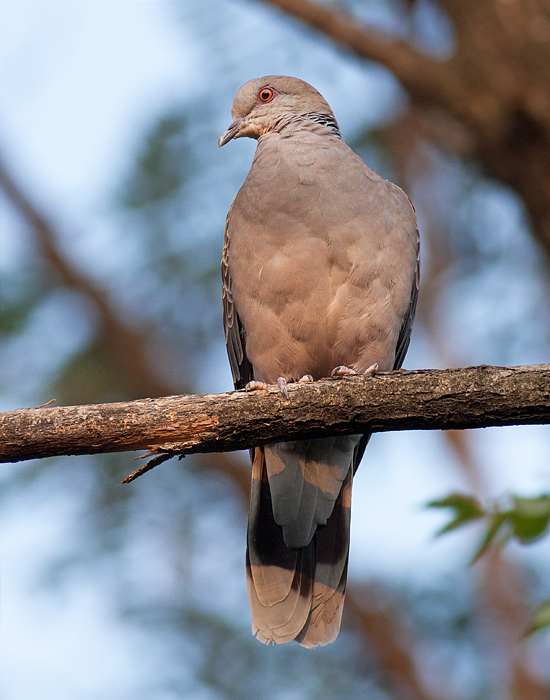 | E-mail to Birds Korea |
 | KWBS |
in the Region
 | The Oriental Bird Club |
 | BirdLife International (Asia) |
September
Temperatures begin to cool, especially towards the end of the month, with maxima often falling from 28°C to 20°C. Sunny, dry weather predominates, though often punctuated by occasional heavy rain and very strong winds associated with typhoons.
September sees the pace of migration pick up considerably. The first returning flocks of geese and Baikal Teal arrive mid-month, while seabirds still provide much interest too, with increasing numbers of jaegers and dark shearwaters possible. While a few shorebirds peak in number in August, most species are present in good numbers throughout September too, with occasionally large numbers of Red-necked Phalarope in the east and south, and small numbers of Nordmann’s Greenshank and Spoon-billed Sandpiper at prime sites, such as the Geum and Nakdong Estuaries. There can also still be large numbers of Common Tern on the move (especially early in the month), while the scarcer Whiskered and White-winged Terns also become rather more widespread - with small flocks of the latter possible especially at Seosan and in Gunsan. Raptor migration picks up too, including by mid-month occasionally large concentrations of the declining Chinese Sparrowhawk making their way towards Japan (where over 50, 000 have been recorded in one day on an island in the Korean Straits only 50 km south of Busan!), with later in the month also an increasing number of Grey-faced Buzzard and Crested Honey Buzzard and very small numbers of Pied Harrier and Amur Falcon - especially through the northwest. Passerines also become rather more numerous and diverse too, with Thick-billed Warbler and Brown Shrike early in the month in the northwest, and good numbers of Eastern Yellow Wagtail, Pechora Pipit, and the three species of "grey-brown flycatchers" by mid-month (some Dark-sided and Brown still, with a peak in Grey-streaked). Towards the very end of September, Olive-backed Pipit migration also starts in earnest, and the first mixed flocks of buntings start to arrive, with most numerous being Chestnut and Black-faced.
National first records for the Republic of Korea in September in the past decade have included Steppe Grey Shrike (2004), Eurasian Dotterel (2005), Willow Warbler (2006), Wood Warbler and Buff-breasted Sandpiper (both in 2007) and Booted Warbler (2011).
Nakdong Estuary and Geum Estuary, September 26 - 28
A “marathon” 3-day weekend (preceded by an afternoon of birding in Igidae in Busan on the 25th) saw multiple Birds Korea objectives met and provided opportunities for information-sharing and survey work focused on the Critically Endangered Spoon-billed Sandpiper and other threatened waterbirds. This post is focused simply on notable bird observations (in the hope that others will write at greater length in separate posts about the seminar, kindly supported financially by K Water; and also about our latest report, “Status of Birds, 2014”).
Due to a rather tight / hectic schedule, observations below were made in two hours in Igidae on the 25th (by NM and Andreas Kim); during nine hours of fieldwork at the Nakdong Estuary on the 26th (NM, AK and Robin Newlin); during four hours of educational program at the Nakdong Estuary on the 27th; and during 13 hours on Yubu Island, Geum Estuary, on the 28th (NM, RN, Jason Loghry, Ha Jung Mun and Patrick Blake), when very large numbers of shorebirds were counted during both the early morning high tide and the especially good evening high tide.
Most notable species included:
- Swan Goose Anser cygnoides. Three were at Yubu on the 28th.
- Common Shelduck Tadorna tadorna. Three were in the Nakdong Estuary on the 27th.
- Falcated Duck Anas falcata. Probably 20+ were in the Nakdong Estuary on the 27th, mixed in with high hundreds of other duck.
- Black-faced Spoonbill Platalea minor. Four were in the Nakdong Estuary on the 26th, with 1-2 there on the 27th; and one was on Yubu on the 28th.
- Chinese Egret Egretta eulophotes. Two or three were in the Nakdong Estuary on the 26th and 27th and probably 10+ were on Yubu on the 28th.
- Black Kite Milvus migrans. One was in Igidae on the 25th and perhaps 15, all of which were juveniles, were in the Nakdong Estuary on the 26th and 27th.
- Far Eastern Oystercatcher Haematopus (ostralegus) osculans. Seven were in the Nakdong Estuary on the 26th and 27th. At least 4,500 were counted in 45 “blocks of 100” from Yubu on the 28th.
- Pacific Golden Plover Pluvialis fulva. Perhaps up to 10 were in the Nakdong Estuary on the 26th; and one was at Yubu on the 28th.
- Grey Plover Pluvialis squatarola. Twenty to thirty were in the Nakdong Estuary on the 26th (including many juveniles) and only c. 300 were on Yubu on the 28th. In autumn 2007, counts on Yubu on August 16th-17th, September 12th and September 28th all found much higher counts of this species, with 2,100 there on September 28th 2007 (SSMP 2007 report).
- Kentish Plover Charadrius alexandrinus. Probably 200 were in the Nakdong Estuary on the 26th and 150 on the 27th. On Yubu on the 28th, 11,000 were counted in one scan of the closer smaller shorebirds, with a total of 15,000 estimated (out of a total 41,800 smaller shorebirds counted an hour or so before high tide). This is a remarkably high count of this fast-declining species, Red-Listed by Birds Korea.
- White-faced Plover Charadrius alexandrinus dealbatus (?). A taxon now split at the species-level by BirdLife International, though regrettably on apparently incorrect ID criteria. On Yubu on the 28th, four or so plovers were obviously (slightly) larger, much heavier-billed and longer-legged, with paler sandy upperparts than typical (presumed nihonensis) Kentish, and all such birds also had pink or pinky-yellow leg colour (when all obvious Kentish were either mostly grey or green-grey legged). These individuals, all seen in the same area as c.30 (now only suspected) White-faced Plover seen last year, recalled Greater Sand or Mongolian Plover at some angles more than Kentish, and at least two were very aggressive towards typical-looking Kentish, driving them away from temporary feeding territories (using a deeper “churritt” call than typical Kentish). Two or three of these had white lores on one or both sides of the head; the best seen individual (with the camera set to darken the images considerably) had extensive dark on the lores on one side and faint brown on the other. Pale at the bill base was looked for in all of these birds but not seen, though conditions were extremely bright. As this bird in the images had large breast patches and no pink at the bill base it was thought possibly to be a Kentish but….might it instead have been White-faced? Correspondence with Jonathan Martinez, who has much experience of breeding and non-breeding “Swinhoe’s Plover” (the perhaps better name for dealbatus, as it is often has marked lores in non-breeding plumage), throws up the possibility that some birds in the ROK might show intermediate characters between “true dealbatus” and “true nihonensis”. Several images of breeding Kentish Plover from the southwest of the country in our gallery, for example, show some pink on the legs (said to be a feature of dealbatus) but otherwise look like typical Kentish. It is clear that much more work is needed still to resolve the status of the various Kentish-type taxa!
- Mongolian Plover Charadrius mongolus. Only sixty or so at the Nakdong Estuary on the 26th and 27th but an estimated 3,000 at Yubu on the 28th.
- Greater Sand Plover Charadrius leschenaultii. One or two at the Nakdong Estuary on the 26th and three at the Geum Estuary on the 28th.
- Eurasian Curlew Numenius arquata. At least 130 were in the Nakdong Estuary on the 26th and an estimated 2,300 were at Yubu on the 28th, with many of these “appearing” shortly before high tide.
- Far Eastern Curlew Numenius madagascariensis. At least 90 were at the Nakdong Estuary on the 26th, though only ~2 were seen there on the 27th. On the 28th, an estimated 2,200 were on Yubu. Many of these “appeared” about an hour before highest tide, and “disappeared” 15 minutes later.
- Nordmann’s Greenshank Tringa guttifer. Five were seen in one scan on Yubu on the 28th, and several others (the same, or an additional 3-4 individuals) were seen at other times of the day.
- Great Knot Calidris tenuirostris. Sixty-five were in the Nakdong Estuary on the 26th and 2,000 were counted in repeated scans along the shoreline at Yubu on the 28th.
- Red Knot Calidris canutus. Five were in the Great Knot flock at the Nakdong Estuary on the 26th and probably 20 were seen at Yubu on the 28th.
- Sanderling Calidris alba. Probably 300-400 were at the Nakdong Estuary on the 26th, and c.500 were at Yubu on the 28th.
- Red-necked Stint Calidris ruficollis. Only 50-100 were seen in the Nakdong Estuary on the 26th (compared with 1500 at the same time last year). At Yubu, there were probably 1,000 present shortly before high-tide. The rather low numbers suggest that the breeding success of the population moving through the ROK might have been lower than last year, when exceptionally good numbers of juveniles were seen. At least one leg-flagged bird was seen, with black over yellow on the right leg (banded in SW Kamchatka in late August this year per Evgeny Syroechkovskiy).
- Little Stint Calidris minuta. Based on structure, one worn juvenile was at the Nakdong Estuary on the 26th. A possible (appearing long-billed, strongly marked on the head, rufous and black with decent white braces) was also seen briefly and poorly digiscoped on Yubu on 28th (NM only).
- Curlew Sandpiper Calidris ferruginea. One was on Yubu on the 28th.
- Dunlin Calidris alpina. About 50 were in the Nakdong Estuary on the 26th and >20,000 were at Yubu on the 28th. One of these was flagged black over yellow (so was banded in SW Kamchatka); another was banded engraved white over blue on the left leg (digiscoped by JL); one had a single orange flag on the right leg; and one had white over orange and another orange over white on the right leg (so both had been banded in the ROK, one more recently than the other).
- Spoon-billed Sandpiper Eurynorhynchus pygmeus. A total of four or five juveniles were seen in the Nakdong Estuary on the 26th, with three seen in one scan there on the 27th (with much less coverage). None had leg-flags. At Yubu on the 28th, nine were counted in a single scan along the western edge on the falling tide (in amongst probably <30% of the 41,800 small shorebirds counted in blocks of 100 two hours before high tide). There were several additional encounters with birds on other parts of the flats before and after this, so an estimated 11 were recorded during the day. Of these three had flags. One Juvenile into First-winter was banded black over yellow (so was one of five juveniles banded in SW Kamchatka in late August by Birds Russia) and two, aged as adults, carried light green flags. One of these flags appeared to be engraved (with a “3” or some such) though was only seen distantly. The least bad image of this bird and flag has been sent onto Nigel Clark at the BTO to try to decipher. Further survey is still required through all tide states to see if there are any more patches of habitat in the Geum Estuary preferred by spoonies that are not usually counted.
- Broad-billed Sandpiper Limicola falcinellus. Probably 5-10 were at the Nakdong Estuary on the 26th and 1,000-1,500 were at Yubu on the 28th.
- Saunders’s Gull Chroicocephalus saundersi. At least 15 were at Yubu on the 28th.
- Relict Gull Ichthyaetus relictus. Two First-winters were seen together in the Nakdong Estuary on the 26th; only one remained there on the 27th. This is likely to be the first September record of this species in the ROK (perhaps, hopefully, the result of a successful breeding season for the Russian population?).
- Vega Gull Larus vegae. At least 18 were in the Nakdong Estuary on the 26th (the first seen in Busan this autumn by NM was on September 18th).
- Taimyr Gull Larus heuglini taimyrensis. At least 24 were in the Nakdong Estuary on the 26th and 2-3 on Yubu on the 28th.
- Gull-billed Tern Gelochelidon nilotica. One in non-breeding plumage (perhaps a First Winter) was found and photographed in the Nakdong Estuary on the 26th. It apparently took a dragonfly before then taking crabs – dropping from several meters up in swoops like an exaggerated Saunders’s Gull. This species is scarcely annually-recorded in the ROK.
- Common Tern Sterna hirundo. Five or more were seen moving south off Igidae on the 25th and at least 80 were in or offshore from the Nakdong Estuary on the 26th, with none were seen there on the 27th.
- Pomarine Skua Stercorarius pomarinus. One was seen flying south off Igidae on the 25th.
- Richard’s Pipit Anthus richardi. At least 15 were in the Nakdong Estuary on the 26th, with three there on the 27th. One was heard over Yubu on the 28th.
- Blyth’s Pipit Anthus godlewskii. One First Calendar-year was heard and seen in the Nakdong Estuary on the 27th.
- Olive-backed Pipit Anthus hodgsoni. Probably 10-15 were heard over Yubu during the 28th, marking the start of autumn migration of this species.
- Pechora Pipit Anthus gustavi. At least six were in the Nakdong Estuary on the 26th, with 2+ there on the 27th and perhaps 5-10 overflying Yubu during the 28th.
- Red-throated Pipit Anthus cervinus. One was in the Nakdong Estuary on the 26th and probably 20-30 were heard overflying Yubu on the 28th, marking the start of autumn migration of this species.

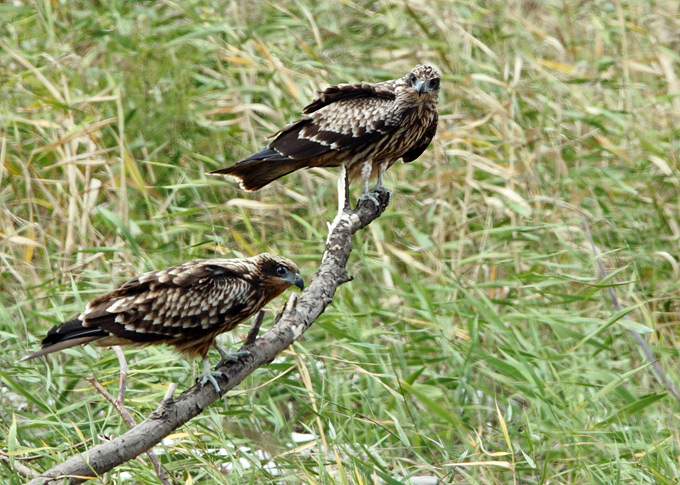



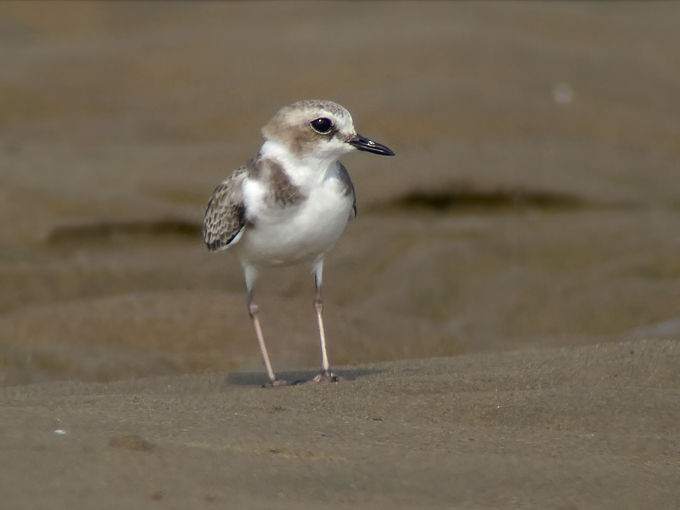

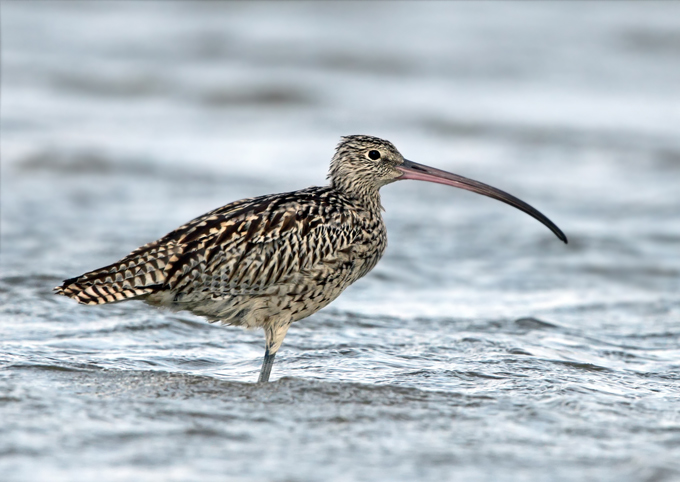

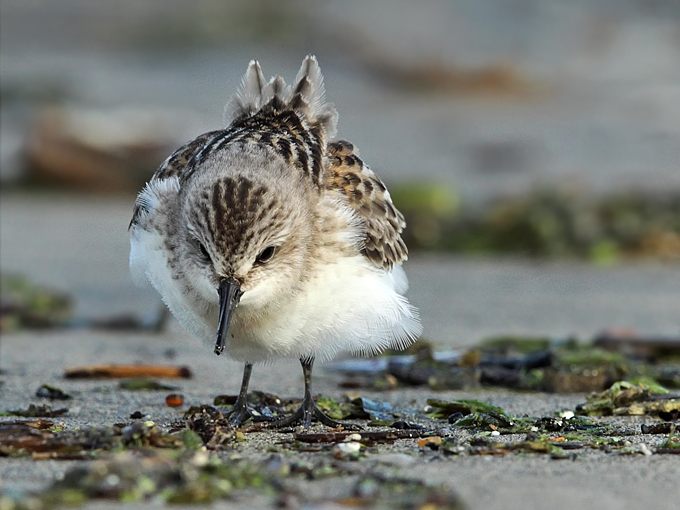


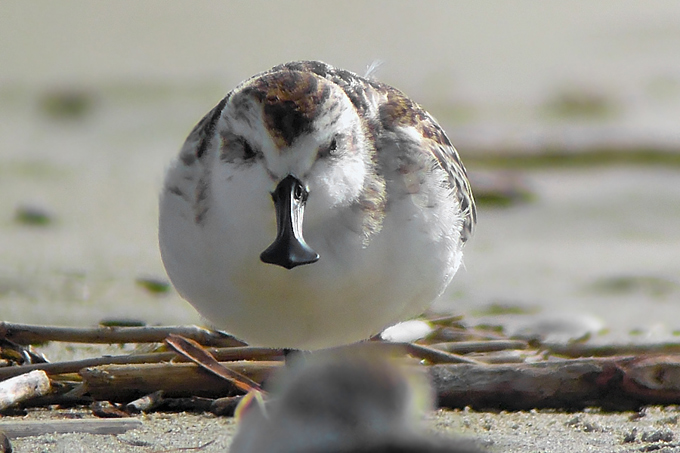
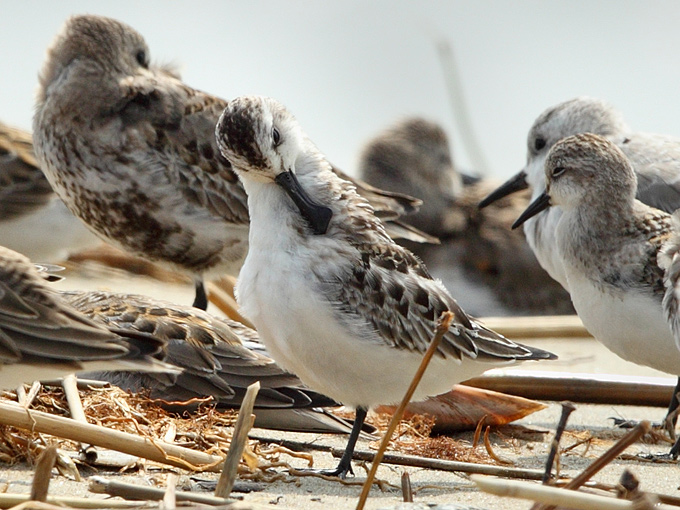




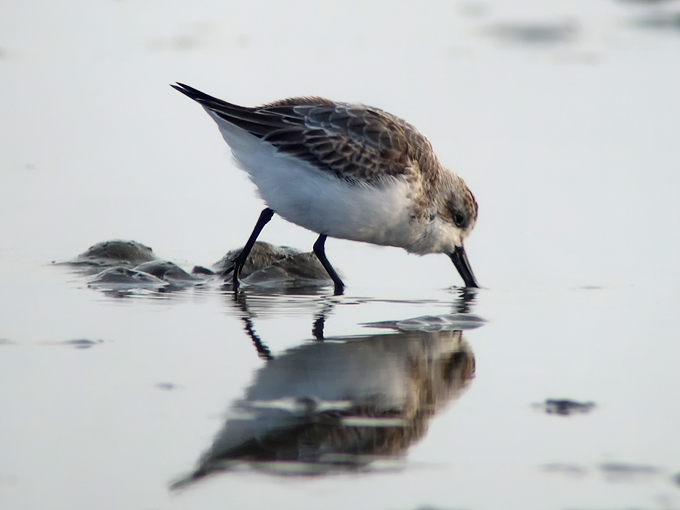
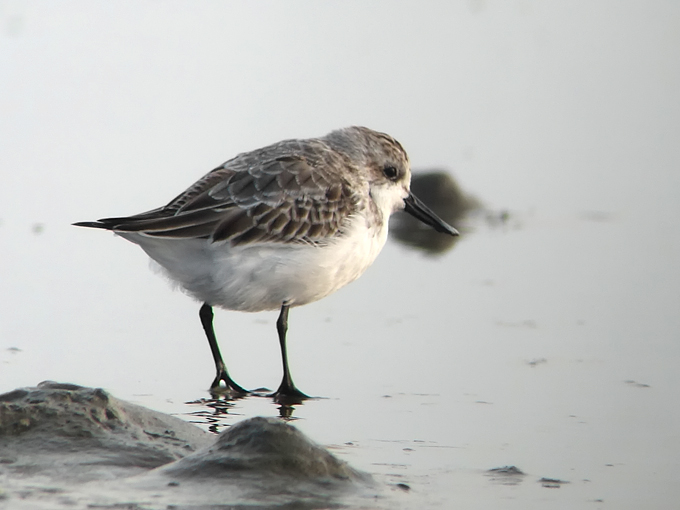
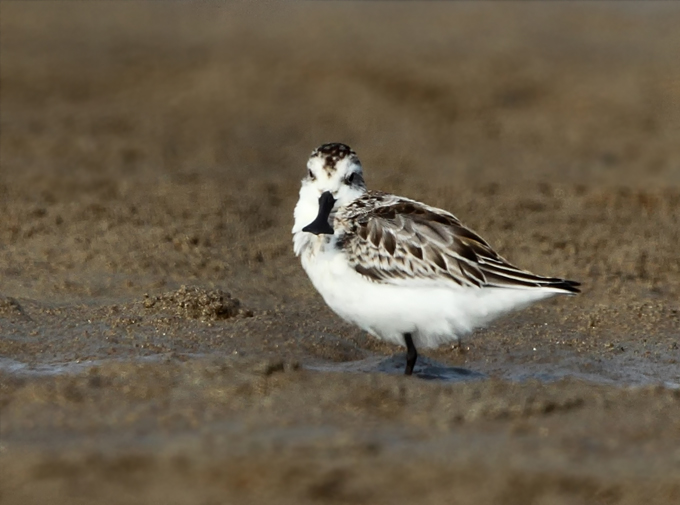

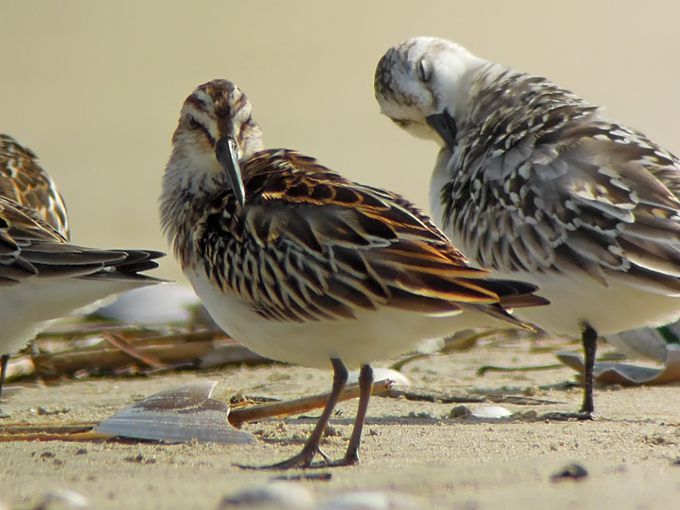
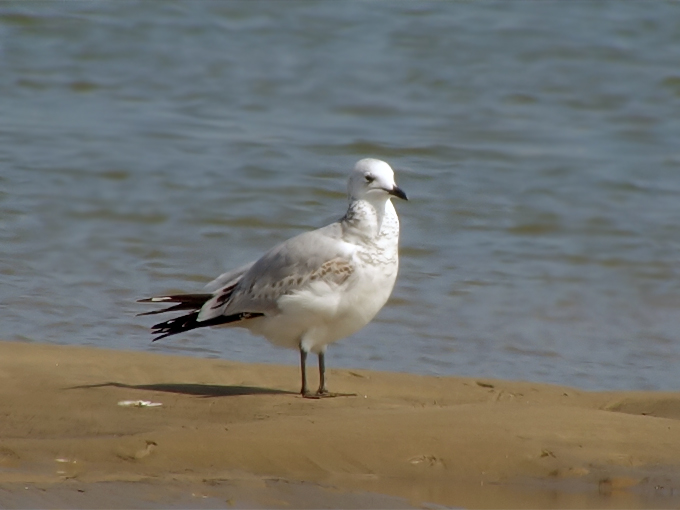
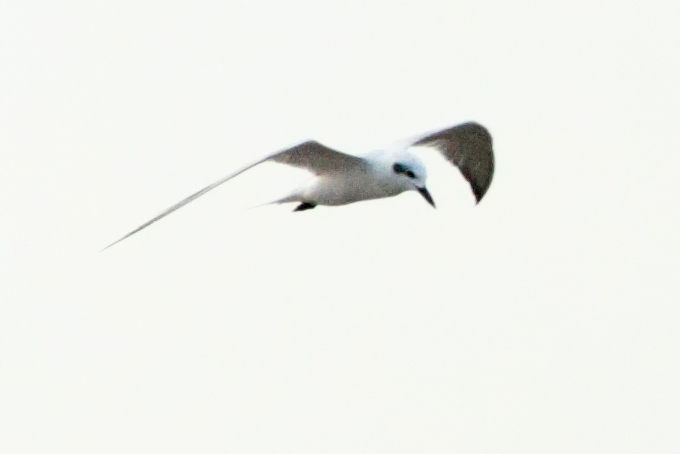

Bongraesan (Busan), September 22
Starting our morning before dawn, we were greeted first by sunrise watchers and early morning hikers. It was a gorgeous clear morning, and a Saturday, so it was no surprise to see so many folks up and out so early. The first birds of the morning were Grey-streaked Flycatchers, which added up to 12 birds by our finishing time. After those first flycatchers, we started to see a few Chinese Sparrowhawk. At around 7am, we spotted our first big flock of 52 together, flying over the hill towards the sea. Then for about an hour we saw a few Northern Hobby (10 for the day), a Peregrine Falcon, and a few Large-billed Crow. Finally at 8am, a second by flock of 60+ Chinese Sparrowhawk flew over. We had a total of only 131 Chinese Sparrowhawk by noon. By ten o’clock, we were seeing very few birds. At noon, we finished. Other interesting species include Japanese Sparrowhawk (1), Arctic Warbler sensu lato (5), Barn Swallow (8), Asian Brown Flycatcher (2), Grey-headed Woodpecker (1) and Great-spotted Woodpecker (1).
Igidae (east Busan), September 15 - 18
Having finished work on the latest Birds Korea report (Status of Birds, 2014), a few hours were spent in the local park on the 15th, 17th and 18th, including 90 minutes seawatching (one hour on 17th and 30 minutes on 18th), in the hope of seeing some early-autumn migrants. Visibility over the sea was good, but few birds were moving, with best 48 Black-headed Gull south on the 17th; and 18 Streaked Shearwater north and three Common Tern, four Mongolian Gull and four Little Egret south on the 18th. On both days, much of the sea was brown with algal blooms, with some patches as red as tomato soup, where water and algae was trapped by seawalls (ironic to note that Busan is presently hosting an international meeting focused on increasing use of marine resources…).
In the woodland, four species of woodpecker (all giving good views), many groups of Brown-eared Bulbul and apparently steadily increasing numbers of Varied (15+), Long-tailed (40+), Eastern Great (c.20) and Coal Tits (c.10), but no sign of any Yellow-bellied Tit (last heard here on September 7th). A single group of 10 Daurian Redstart on 18th also suggested that this species too was on the move. Numbers of most complete migrants were pretty low despite the promising weather (with overcast and occasional spells of rain on the 17th and 18th), but included one Northern Boobook, three Black-naped Oriole, two Blue-and-White and 3+ Grey-streaked Flycatchers, probably a dozen Arctic Warbler, and one possible Japanese Leaf Warbler, heard briefly on the 17th). There were no hirundines or Pacific Swift and no raptors obviously on the move, with instead one Black Kite, three Common Kestrel, 2-3 Eurasian Hobby and two Peregrine Falcon blogging up and down the coast.



Gangneung, September 13 - 14
A stroll near Gyeongpo Lake on the afternoon of the 13th found e.g. a Chinese Pond Heron, two Common Kingfisher, Hobby, one or two Mongolian Gull (on the lake), close views of an Oriental Reed Warbler, Bull-headed Shrike, Striated Heron, 3 Common Snipe (which conversed non-stop with eachother in harsh calls towards dusk), and of most interest, an apparent juvenile Lesser Cuckoo, which allowed close views as it returned repeatedly to the same tree, gorging itself on catterpillars. Identification was based on the rather small size and neat, slim build; very bold, large white spotting along the uppertail (as depicted in Brazil, 2009), and barely visible very fine white trim on the coverts.
One the 14th, a few hours seawatching from the outer wall of the harbour produced two juvenile Pomarine Skua and an early Vega Gull, identifiable on e.g. structure and shading, steep forehead, and diffuse but faint blotching head and nape (not present on the earlier Mongolian). Best perhaps, prolonged views of some 500 Common Tern, most of which idled in a long raft, occasionally roused into a great white cloud, and a close encounter with two Ruddy Turnstone.
Along the beach and at the mouth of the nearby Namdae Stream, a Mandarin Duck, already nine Sanderling, a Red-necked Stint, four Grey-tailed Tattler and a Common Sandpiper.

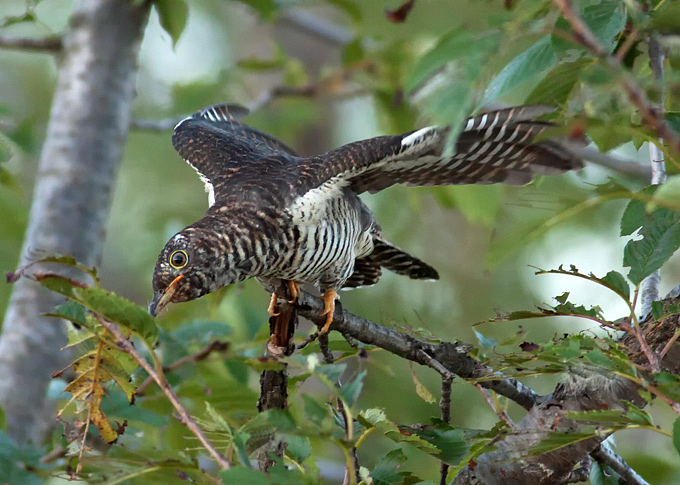

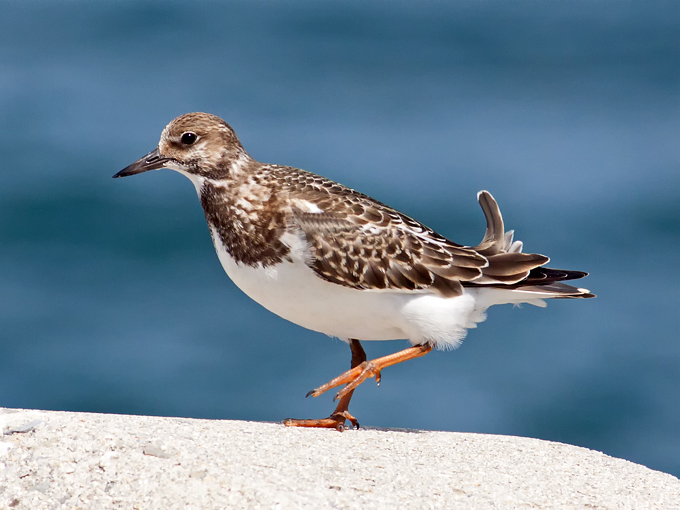
Paju, September 12
A morning only poking around rice fields at Paju yielded about 20 snipe, made (more) difficult by distance and poor lighting: most appeared to be Commons while 3 or 4 looked like Pin-tailed. Other highlights: 2 Black-faced Spoonbills, 2 Chinese Pond Herons, 1 Pallas’s Grasshopper Warbler, 3 Wood Sandpipers, 1 Long-toed Stint, 1 Common Kingfisher, a few Pheasants, several Kestrels and a probable (from call) Pechora Pipit.

Gageo Island, September 6 - 9
Spent the Chuseok holiday on Gageo-do, hoping to catch some migrants on their movement south. Weather throughout the trip was perfect, with predominantly clear sunny skies; this was probably the reason there was a decided lack of migrants. However, several unusual and unexpected species were observed. Highlights include Styan’s Grasshopper Warbler, Long-tailed Shrike, Brown Shrike, and some good pelagic birding on the ferries to and from Gageo-do. See below for more information.
- Streaked Shearwater Calonectris leucomelas – a single bird on the ride out to Gageo-do near Tae-do; 3 separate birds around Gageo-do on the return trip
- Swinhoe’s Storm Petrel Oceanodroma monorhis – 30+ on the way to Gageo-do; 40+ on the return trip
- presumed Band-rumped Storm Petrel Oceanodroma castro – 3 individual birds observed amid Swinhoe’s Storm Petrels on the way to Gageo-do. Clearly seen white rump on an overall dark-colored storm petrel; ruled out Leach’s Storm Petrel because of rounded tail (not forked) and no appearance of a small dark stripe across the white rump band (although not all Leach’s show this stripe; some Leach’s do not show a white rump at all). No photos were possible (outside access is restricted on the ferry), but the white rump was clearly obvious during the observations, so Swinhoe’s is unlikely
- Eastern Cattle Egret Bubulcus coromandus – 1 bird in Gageodo-ri on the 6th; 3 birds on the 8th and 9th
- Grey Heron Ardea cinerea – 15+ at the main harbor in Gageodo-ri most days
- Eastern Great Egret Ardea a. modesta – 1 at the main harbor in Gageodo-ri on the 7th; 2 on the 9th
- Pacific Golden Plover Pluvialis fulva – 1 on the pebble beach at Gageodo-ri on the 6th and 7th
- Kentish Plover Charadrius alexandrinus – 1 on the pebble beach at Gageodo-ri on the 6th
- Latham’s Snipe Gallinago hardwickii – 1 flushed at the Sky Park near Gageodo-ri on the 6th; 1 flushed near Hangri-maeul on the 7th
- Wood Sandpiper Tringa glareola – common, with 3-5 being seen most days
- Common Sandpiper Actitis hypoleucos – 2 observed on the 7th
- Ruddy Turnstone Arenaria interpres – 2 observed on the 7th
- Red-necked Stint Calidris ruficollis – 1 observed at Gageodo-ri on the 7th; 6 observed there on the 9th
- Long-toed Stint Calidris subminuta – 1 observed at Gageodo-ri on the 9th
- Red-necked Phalarope Phalaropus lobatus – 12 observed on the ferry ride near Heuksan-do on the 6th
- Black Wood Pigeon Columba janthina – 1 observed on the 8th
- White-throated Needletail Hirundapus caudacutus – 5 observed near Hangri-maeul on the 7th
- Pacific Swift Apus pacificus – 10+ observed near Hangri-maeul on the 7th
- Oriental Dollarbird Eurystomus orientalis – 1 observed near Gageodo-ri on the 6th; 1 observed in the interior mountains on the 8th
- Common Kingfisher Alcedo atthis – 1 observed at Gageodo-ri on the 6th; 1 observed near Hangri-maeul on the 7th
- Eurasian Wryneck Jynx torquilla – 1 observed near Hangri-maeul on the 7th
- White-backed Woodpecker Dendrocopos leucotos – 1 heard calling near Sam-gu on the 8th
- Common Kestrel Falco tinnunculus – 1 or 2 observed most days around Gageodo-ri
- Peregrine Falcon Falco peregrinus – 1 observed near Hangri-maeul on the 7th; 2 observed near Sam-gu and the interior mountains on the 8th
- Bull-headed Shrike Lanius bucephalus – 1 juvenile observed near Gageodo-ri on the 9th
- Brown Shrike Lanius cristatus – 2 observed; 1 around Gageodo-ri on the 6th, 8th, and 9th; a second at Hangri-maeul on the 7th
- Long-tailed Shrike Lanius schach – 2 observed; 1 at the Sky Park near Gageodo-ri on the 7th; 1 observed at Hangri-maeul, also on the 7th
- Varied Tit Poecile varius – 3 observed near Hangri-maeul on the 7th; 5+ observed near Sam-gu on the 8th
- Eastern Great Tit Parus minor – 5+ observed near Hangri-maeul on the 7th; 2 observed near Sam-gu on the 8th
- Light-vented Bulbul Pycnonotus sinensis – common around the villages; usually 30-40+ per day
- Brown-eared Bulbul Hypsipetes amaurotis – not as common as the LVBU; usually 10+ per day
- Barn Swallow Hirundo rustica – 2 or 3 observed each day
- Pacific Swallow Hirundo tahitica – 10+ observed near Hangri-maeul on the 7th; singles on other days
- Dusky Warbler Phylloscopus fuscatus – most common warbler observed; 10+ on the 7th and 8th
- Yellow-browed Warbler Phylloscopus inornatus – 1 observed near Hangri-maeul on the 7th; 3+ in Sam-gu on the 8th
- Eastern Crowned Warbler Phylloscopus coronatus – 1 observed near Hangri-maeul on the 7th
- Pale-legged Leaf Warbler Phylloscopus tenellipes – 1 heard along the interior of the island on the 8th
- Styan’s Grasshopper Warbler Locustella pleskei – 1 observed near the Sky Park at Gageodo-ri on the 6th and 7th
- Japanese White-eye Zosterops japonicus – very common; 100+ per day
- Pale Thrush Turdus pallidus – 8+ heard and observed in the interior of the island on the 8th
- Grey-sided Flycatcher Muscicapa griseisticta – very common; 10+ observed most days, especially around Gageodo-ri and the western road leading to Hangri-maeul
- Siberian Blue Robin Larvivora cyane – 1 observed along the central road leading to Gageodo-ri on the 8th
- Blue Rock Thrush Monticola solitarius – very common around the villages; 5+ observed each day
- Stejneger’s Stonechat Saxicola stejnegeri – 1 observed at the Sky Park by Gageodo-ri on the 6th
- Eastern Yellow Wagtail Motacilla tschutschensis – 1 observed at Gageodo-ri on the 7th; 3 observed there on the 9th
- Grey Wagtail Motacilla cinerea – common; 3-5 observed each day, especially around Gageodo-ri
- White Wagtail Motacilla alba leucopsis – common; 4+ observed each day, especially around Gageodo-ri
- Richard’s Pipit Anthus richardi – 3 observed at Hangri-maeul on the 7th
- Chinese Grosbeak Eophona migratoria – a large flock of around 30+ birds observed atop the ridge above Gageodo-ri on the 7th

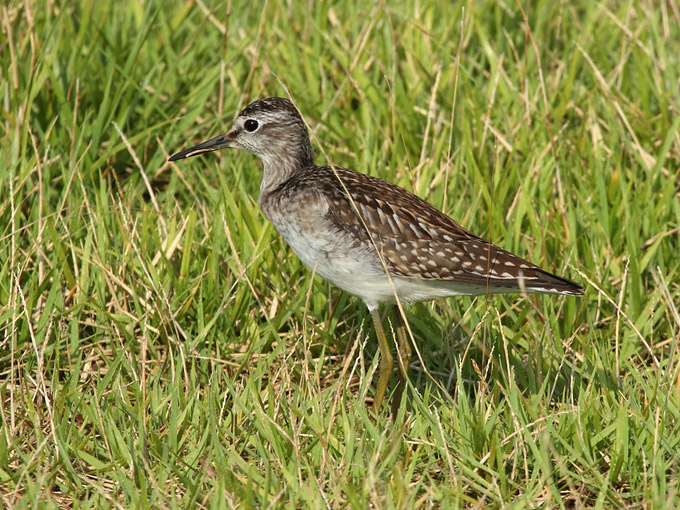

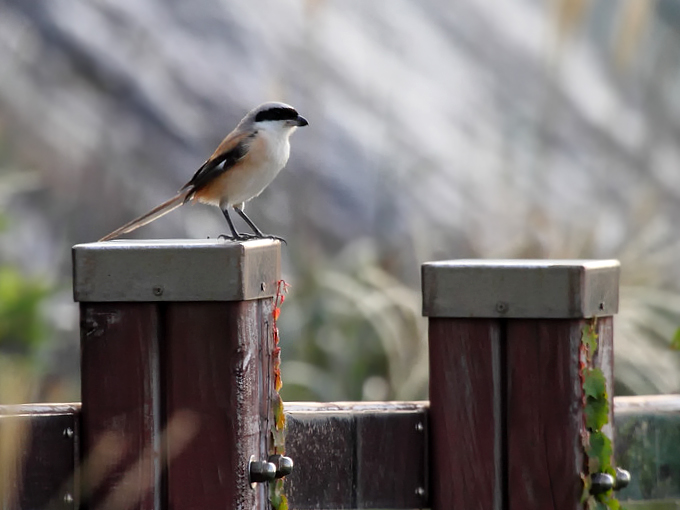
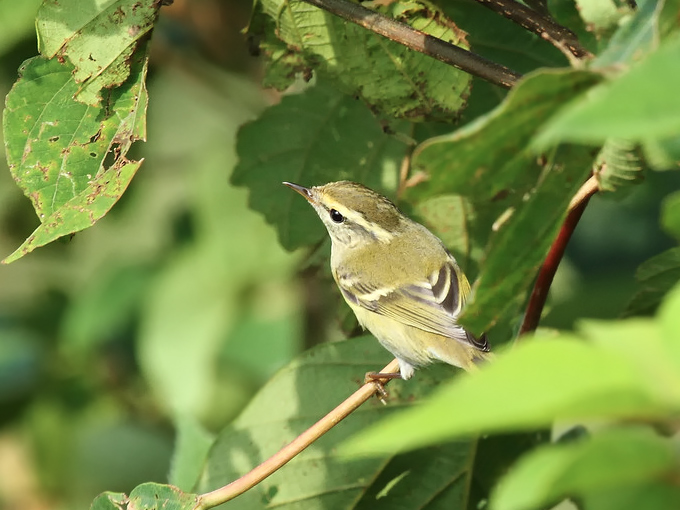
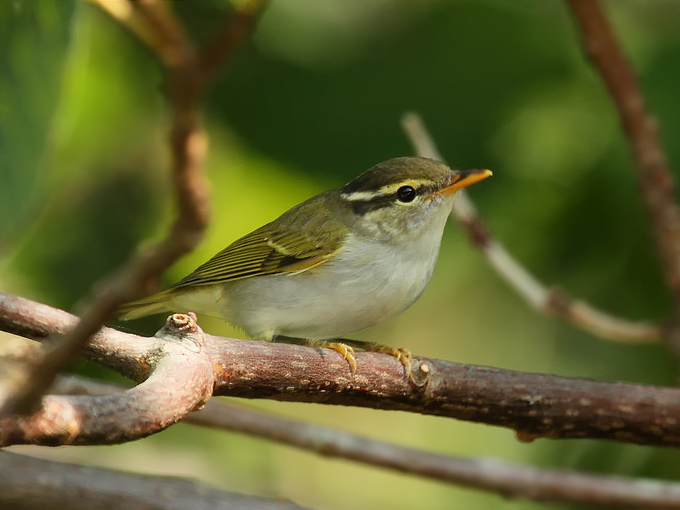


Cheongdam Park, September 8
Very tough going birding this small urban park- almost nothing to speak of, although best single Grey-streaked Flycatcher, Eastern Crowned Warbler, Yellow-browed Warbler, and Asian Stubtail.
Among the commoner sights, several Jay (which show a surprising range of mimicked calls) and Oriental Turtle Dove.
